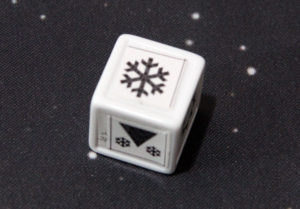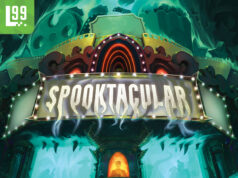Note: This preview uses pre-release components and rules. What you see here may be different from the final, published game.
 While climbing to the peak of a mountain sounds like an adventure of a lifetime, I’m not sure I would make it. Summit, however, feels like it takes some of those same decisions you might really be making and puts them to use in a board game. You must race to the top of the mountain and back down… and do it safely.
While climbing to the peak of a mountain sounds like an adventure of a lifetime, I’m not sure I would make it. Summit, however, feels like it takes some of those same decisions you might really be making and puts them to use in a board game. You must race to the top of the mountain and back down… and do it safely.
Summit plays 2-6 players and takes about 20 minutes per player. It is the first game from Inside Up Games and is currently in funding on Kickstarter.
Game Overview:
In Summit, players control one climber as they attempt to be the first to ascend and descend the mountain. Along with moving as quickly as possible, climbers will be given the opportunity to help or hinder fellow climbers, which will impact their karma.
Each turn players will choose an action, often times climbing up the mountain. Then dice will determine the current weather which will impact how many resources are used by each player. There is also an event die and each turn there is a chance a random event will occur.
Once all players have made their way down the mountain, the game ends and points are scored based on the order players hit checkpoints along the way. Additionally, your karma is added to that total and the player with the most points wins.
How to Play

Summit can be set up with various difficulty levels, basically by adjusting how far down the mountain you start your climb. Each player gets a unique character that has their own special ability, with some being more adept at carrying supplies than others.
Items are then drafted to start the game. Each player can draft 0, 1, or 2 items at the beginning. Items give you a positive ability, but often add weight that can slow you down. Apparently more is not always better when it comes to climbing a mountain. Players will also receive 4 karma cards that can be used to help or hinder other climbers as well as 3 triangular tiles that are placed on the mountain as you ascend.
Finally, before starting their climb, each player can choose how much oxygen and food to take. Again, the more you take, the heavier your pack will be and you will be forced to move slower. But running out of supplies can also slow you down and potentially leave you dead on the side of the mountain.
On each turn, you can either move up the mountain, or skip your movement to remove a token or card that has been given to you. If none of your tiles are helpful for the path you’d like to take, you may also skip your movement to discard your tiles and draw three new ones. When moving, each knot on the tile is one space and players can move spaces equal to their speed. If a player is leaving a tile and onto an empty space, they choose one of their three tiles to place on the board.

The mountain tiles come in essentially three flavors. Normal tiles that don’t have any special effect and allow players to quickly move through. Blue ice tiles have many more knots and slow players down. Finally, thin air tiles force players who enter them to use one oxygen from their supply.
After movement is complete, players draw back up to their limit of tiles and any karma cards if they were played. Then the weather die is rolled and based on the result, the climber must use food from their supply. If the blizzard side is rolled, the token on the blizzard track goes up and all players must spend the resources shown on the track.
When moving, you cannot pass through other players without their permission. If you allow another climber to move through you, your karma will increase. Alternatively, if you make them wait or go around, you will move down on the karma track. At any point during your turn you can drop items to lighten your load and potentially increase your speed. Dropped items are set to the side and a token is placed on that tile. Climbers on or adjacent to that tile in the future can pick up items there.
There is a halfway camp you can stop at on the way up or down the mountain. When you begin your turn in the camp, you can choose to take an alternate turn to rest and restore 3 health, reload on as much food and oxygen as you would like, or draw three item cards and keep as many of them as you’d like.
You score points as you reach the halfway camp, the summit, the halfway camp on descent, and finally the base camp. These points, plus your points from the karma track, become your total score. The highest total score wins.

Thoughts on the Game Experience
First off, I love the theme of Summit. It feels adventurous and the decisions you make, while not really life and death, certainly can feel that way for your character. You have to make some tough choices along the way and you can employ different strategies to be successful.
The karma cards are a bit of a mixed bag. Some of them are exceptionally punishing. However, playing them on other players comes at a cost as negative cards will move you down the karma track and you will end up with a lower score. As enticing as it can be to hurt other players often, it’s a delicate balancing act. You really have to time it right so that you aren’t hurting yourself more than the target of your play. They do act as a bit of a catch-up mechanic as a runaway leader will often see multiple players spend their karma to slow him down and catch him up to the group. Alternatively, positive karma cards can be used on the climbers in the back of the pack to move up the karma track.

The system to track your resources, weight, and speed really brings the theme to life. Taking on more food or items will certainly slow you down, but you don’t want to get stranded without enough supplies. It can be easy to forget to move your weight and speed markers as you consume resources, but it’s easy enough to double-check at any time that everything is in the right place. Having the option to leave items in the snow to speed up allows players to change tactics as needed. In many plays, as we became more familiar with the game, we quickly decided to leave everything on the mountain on the last turn or two as we wanted to get back to base camp as quickly as possible.
As a competitive game, I enjoyed Summit the most with higher player counts. You run into each other a lot and have to move efficiently and often get stuck behind other players. Also, the karma cards really shine as there are many options for targets and it doesn’t feel quite as mean as it does with fewer players. There are alternative rules for cooperative and solo play as well if that is more your style. The cooperative mode removes karma cards and players work together, scoring points for the number of players who successfully make it up and down the mountain.
Final Thoughts

Summit is a racing game with a unique theme. Players have many interesting decisions to make, as they can pack lightly and make a run for base camp or really load up on supplies to make sure they don’t need to backtrack, even if other players get in their way. Most importantly, as weather and situations change, players can alter their strategy and ditch unneeded items to lighten their load for the final climb.
As a competitive game, Summit can be unpredictable and mean, but it works well with the theme. Its best at 4+ players, as with the lower player counts the karma cards don’t work as well and there isn’t much contention for space to move around.
If you’d like to become a backer, pledges start at $49 CAD for the full game and stretch goals. Summit is scheduled to be in backers hands in May of 2017 and you have until Wednesday, June 6th to become a backer. Head over today and check it out.
As always, we don’t post ratings for preview copies as the components and rules may change from the final game. Check back with us after the game is produced for a full review.





















